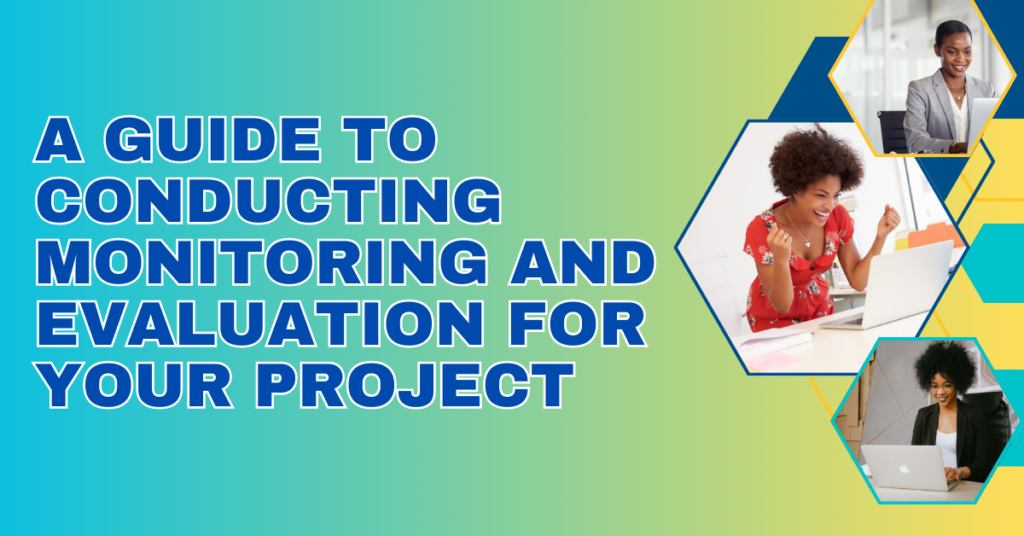
Menu
Facebook-f
Twitter
Google-plus-g
A Guide to Conducting Monitoring and Evaluation for Your Project
Hello, we understand how conducting and documenting Monitoring and Evaluation (M&E) of an NGO project proposal can be challenging, but with a clear understanding of the process, you can create an effective and detailed plan. This guide will take you through each step of this journey.
- Understand the Purpose of Monitoring and Evaluation
Before you start writing, it’s essential to understand what Monitoring and Evaluation (M&E) means.
- Monitoring: This is the process of regularly tracking the progress of your project to ensure it’s on the right path. It involves collecting data and information to see if the project is being implemented as planned.
- Evaluation: Evaluation goes a step further by assessing whether the project has achieved its goals and objectives. It’s about measuring the impact of the project and determining what worked well and what didn’t.
- Start with the Monitoring Plan
The monitoring plan outlines how you will keep track of the project’s progress.
Step 1: Define Key Performance Indicators (KPIs)
- What are KPIs? These are specific, measurable indicators that help you see whether the project is moving in the right direction. For example, if your project aims to improve literacy among children, a KPI could be “the number of children who can read a simple sentence after three months of training.”
- How to Choose KPIs: Select indicators that are directly related to your project goals. Make sure they are measurable, achievable, and relevant. Ask yourself: What will I measure? How will I measure it?
Step 2: Determine the Monitoring Methods
- What methods will you use? Think about how you will gather information. Will you use surveys, interviews, or observations? For example, if you are monitoring the health of a community, you might conduct regular health check-ups and keep records.
- Who will collect the data? Decide who will be responsible for gathering the information. Will it be your project team, local volunteers, or external experts?
Step 3: Establish the Monitoring Timeline
- When will monitoring take place? Set a schedule for monitoring activities. Will you check progress weekly, monthly, or quarterly? Be realistic about how often you can gather data without overwhelming your team.
- Set milestones: Milestones are specific points in the project when you expect certain goals to be met. For example, if you are building a school, a milestone might be “foundation completed by the end of the first month.”
Step 4: Document the Monitoring Process
- Create a monitoring plan document: This should include your KPIs, methods, responsible persons, and timeline. This document will guide your team and help ensure consistency in how monitoring is done.
- Move on to the Evaluation Plan
The evaluation plan explains how you will assess the success and impact of the project.
Step 1: Define the Evaluation Objectives
- What do you want to learn from the evaluation? Your objectives might include understanding the effectiveness of the project, identifying areas for improvement, or measuring the impact on the target community.
- Example: If your project is about improving access to clean water, an evaluation objective might be “to assess the reduction in waterborne diseases in the community.”
Step 2: Choose the Evaluation Type
- Formative Evaluation: Conducted during the project to improve its design and performance.
- Summative Evaluation: Conducted at the end of the project to assess its overall impact and success.
- Which one to choose? If you want to make improvements while the project is still running, go for formative evaluation. If you want to see the final results, choose summative evaluation. You can also do both.
Step 3: Determine the Evaluation Methods
- What tools will you use? Like monitoring, evaluation requires gathering data. You can use methods like surveys, interviews, focus groups, or data analysis. For example, if you want to know if children’s health improved due to your project, you could analyze health records before and after the project.
- Who will conduct the evaluation? Decide if your team will do the evaluation or if you’ll hire external experts for an unbiased assessment.
Step 4: Create an Evaluation Timeline
- When will you evaluate? Set specific dates for when the evaluation will take place. Make sure the timing aligns with the project’s milestones and completion.
- Example: If your project ends in December, you might plan an evaluation in January to assess the final impact.
Step 5: Analyze and Interpret the Data
- How will you make sense of the information? After gathering data, analyze it to draw conclusions. Look for patterns, trends, and insights. For example, if your project aimed to reduce malnutrition, compare the rates of malnutrition before and after the project to see if there was an improvement.
Step 6: Report the Findings
- Prepare an evaluation report: Summarize the findings in a clear and concise report. Include the objectives, methods, results, and recommendations for future projects. This report will help you understand what worked and what didn’t, and guide future efforts.
- Integrate Monitoring and Evaluation into Your Project Proposal
Once you have your monitoring and evaluation plans, it’s time to include them in your project proposal. Here’s how to do it:
Step 1: Write the Monitoring Section
- Introduction: Start with a brief explanation of why monitoring is essential for your project.
- Monitoring Plan: Describe the KPIs, methods, timeline, and who will be responsible for monitoring. Make sure this section is clear and easy to follow.
- Example:
- Objective: To track the progress of the literacy training program.
- KPI: Number of children who can read a sentence after three months.
- Method: Monthly reading tests conducted by teachers.
- Timeline: Monitoring will be done monthly, with a mid-term review after three months.
Step 2: Write the Evaluation Section
- Introduction: Explain the purpose of evaluation and what you hope to achieve.
- Evaluation Plan: Describe the evaluation objectives, type, methods, timeline, and responsible persons.
- Example:
- Objective: To assess the impact of the clean water project on community health.
- Type: Summative evaluation at the end of the project.
- Method: Health surveys and data analysis comparing disease rates before and after the project.
- Timeline: Evaluation will be conducted in the month following project completion.
Step 3: Make Sure It’s Aligned with the Rest of the Proposal
- Consistency: Ensure that your M&E section aligns with the overall project goals, objectives, and activities. The KPIs should match the outcomes you hope to achieve, and the evaluation methods should be suitable for the type of project you are proposing.
- Clarity: Write in simple language, avoiding jargon. The M&E section should be easy to understand, even for someone not familiar with the project.
- Review and Finalize Your M&E Section
After writing the M&E section, review it carefully.
Step 1: Check for Completeness
- Is everything covered? Ensure you have included all the necessary details, such as KPIs, methods, timelines, and responsibilities.
Step 2: Get Feedback
- Ask for input: Share the section with colleagues or mentors to get feedback. They might spot areas that need improvement or suggest additional indicators or methods.
Step 3: Revise and Edit
- Make improvements: Based on the feedback, make any necessary revisions. Check for clarity, coherence, and alignment with the rest of the proposal.
Step 4: Finalize the Document
- Proofread: Go through the document to correct any spelling or grammatical errors.
- Finalize: Once you’re satisfied, save the final version of the M&E section and include it in your project proposal.
Conclusion
Writing the Monitoring and Evaluation section of an NGO project proposal may seem complex, but by following these steps, you can create a clear and effective plan. Remember to focus on simple, measurable indicators, choose appropriate methods, and set realistic timelines. Monitoring helps you track progress, while evaluation allows you to assess the impact, making both essential components for a successful project. With practice, you’ll become more comfortable with M&E, and your proposals will be stronger and more compelling.
Address List
-
Makerere Hill Road, Ham Towers -
+256-703947778 -
info@professionalwriters.shop
Social Networks
Links List
Professional Writers Inc.
Turning Ideas Into Reality
Business Plan Writing Training [Free]







